weight Hyundai Elantra 2006 Owner's Manual
[x] Cancel search | Manufacturer: HYUNDAI, Model Year: 2006, Model line: Elantra, Model: Hyundai Elantra 2006Pages: 277, PDF Size: 10.18 MB
Page 29 of 277
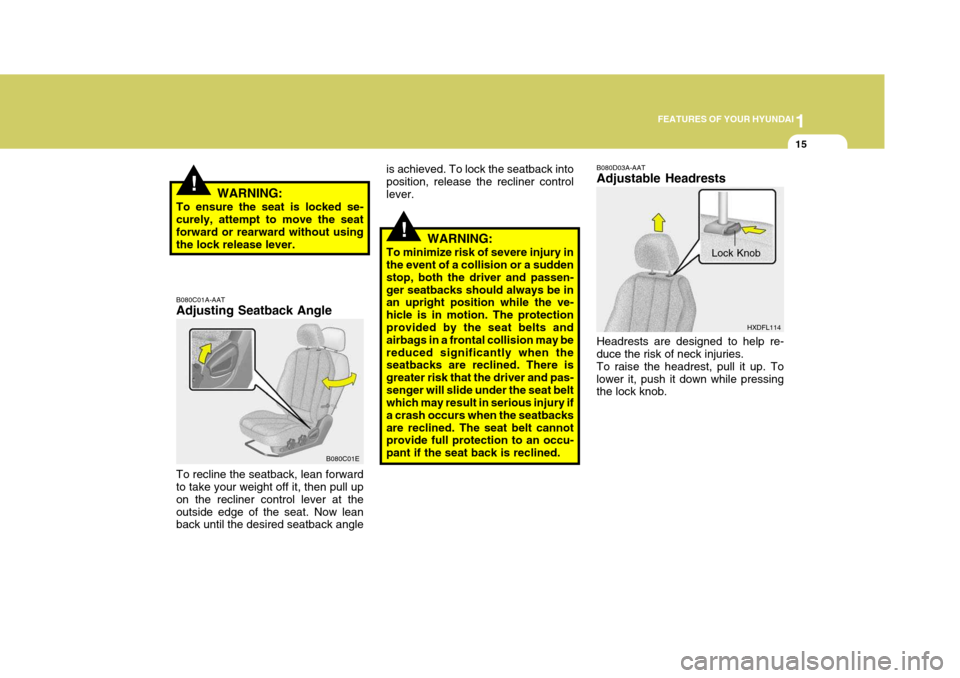
1
FEATURES OF YOUR HYUNDAI
15
!
!WARNING:
To minimize risk of severe injury in the event of a collision or a sudden stop, both the driver and passen-ger seatbacks should always be in an upright position while the ve- hicle is in motion. The protectionprovided by the seat belts and airbags in a frontal collision may be reduced significantly when the seatbacks are reclined. There is greater risk that the driver and pas-senger will slide under the seat belt which may result in serious injury if a crash occurs when the seatbacksare reclined. The seat belt cannot provide full protection to an occu- pant if the seat back is reclined.
To recline the seatback, lean forward to take your weight off it, then pull up on the recliner control lever at theoutside edge of the seat. Now lean back until the desired seatback angle B080C01E
B080C01A-AAT Adjusting Seatback Angle
WARNING:
To ensure the seat is locked se- curely, attempt to move the seat forward or rearward without using the lock release lever. is achieved. To lock the seatback intoposition, release the recliner controllever.
Lock Knob
HXDFL114
B080D03A-AAT Adjustable Headrests Headrests are designed to help re- duce the risk of neck injuries. To raise the headrest, pull it up. Tolower it, push it down while pressing the lock knob.
Page 55 of 277
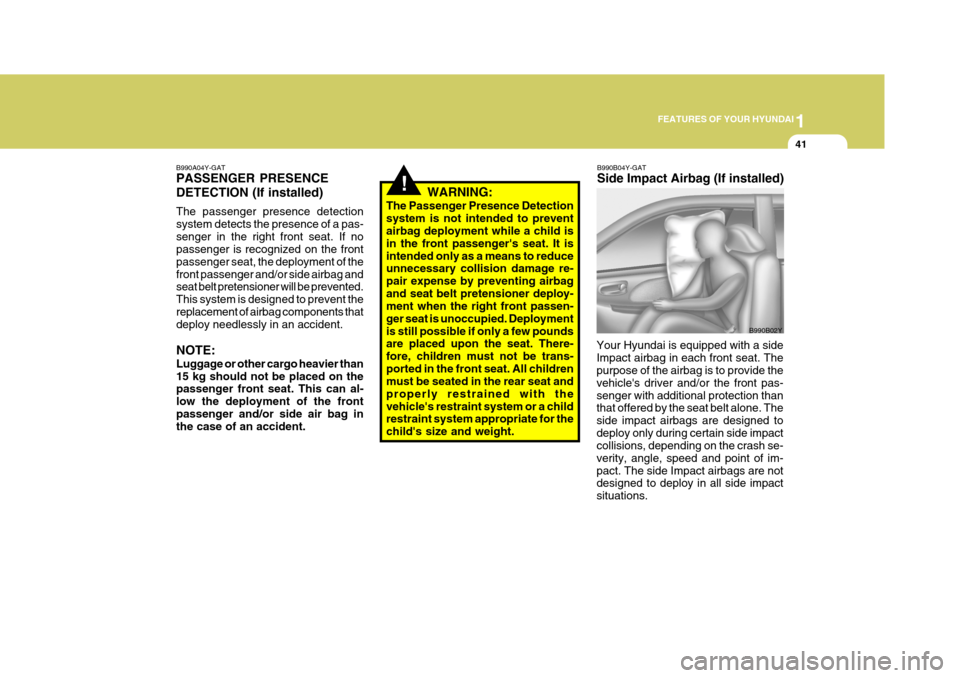
1
FEATURES OF YOUR HYUNDAI
41
!WARNING:
The Passenger Presence Detection system is not intended to prevent airbag deployment while a child is in the front passenger's seat. It isintended only as a means to reduce unnecessary collision damage re- pair expense by preventing airbagand seat belt pretensioner deploy- ment when the right front passen- ger seat is unoccupied. Deploymentis still possible if only a few pounds are placed upon the seat. There- fore, children must not be trans-ported in the front seat. All children must be seated in the rear seat and properly restrained with thevehicle's restraint system or a child restraint system appropriate for the child's size and weight.
B990A04Y-GAT PASSENGER PRESENCE DETECTION (If installed) The passenger presence detection system detects the presence of a pas-senger in the right front seat. If no passenger is recognized on the front passenger seat, the deployment of thefront passenger and/or side airbag and seat belt pretensioner will be prevented. This system is designed to prevent thereplacement of airbag components that deploy needlessly in an accident. NOTE: Luggage or other cargo heavier than 15 kg should not be placed on the passenger front seat. This can al- low the deployment of the frontpassenger and/or side air bag in the case of an accident.
B990B04Y-GAT Side Impact Airbag (If installed)
Your Hyundai is equipped with a side Impact airbag in each front seat. The purpose of the airbag is to provide the vehicle's driver and/or the front pas-senger with additional protection than that offered by the seat belt alone. The side impact airbags are designed todeploy only during certain side impact collisions, depending on the crash se- verity, angle, speed and point of im-pact. The side Impact airbags are not designed to deploy in all side impact situations. B990B02Y
Page 83 of 277
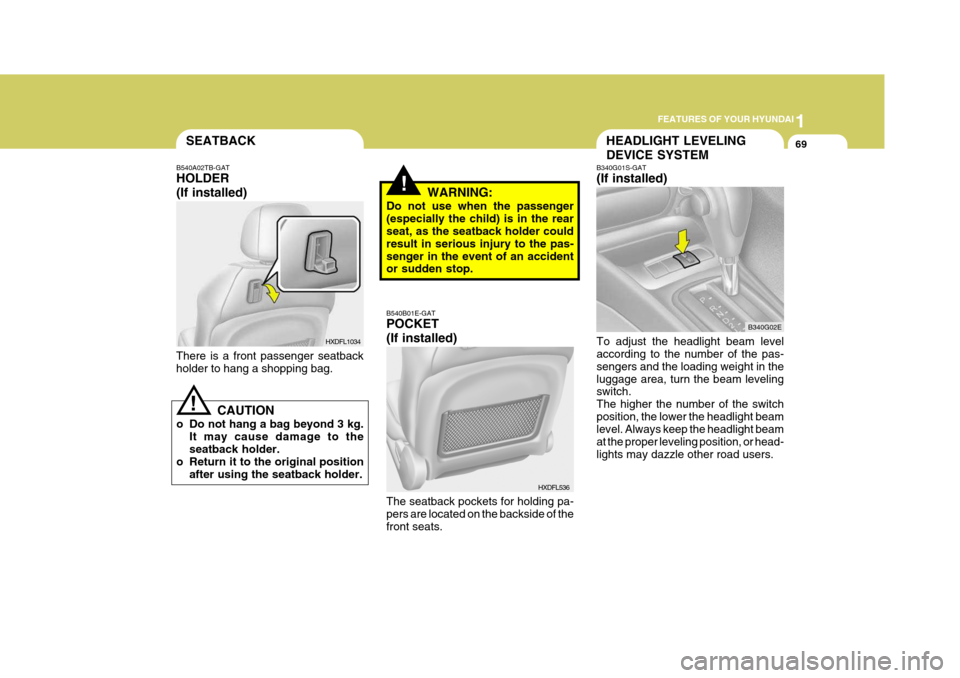
1
FEATURES OF YOUR HYUNDAI
69HEADLIGHT LEVELING DEVICE SYSTEMSEATBACK
B340G01S-GAT (If installed) To adjust the headlight beam level according to the number of the pas- sengers and the loading weight in theluggage area, turn the beam leveling switch. The higher the number of the switchposition, the lower the headlight beam level. Always keep the headlight beam at the proper leveling position, or head-lights may dazzle other road users.B340G02E
B540B01E-GAT POCKET (If installed)
HXDFL536
There is a front passenger seatback holder to hang a shopping bag.
HXDFL1034
B540A02TB-GAT HOLDER (If installed)
!
CAUTION
o Do not hang a bag beyond 3 kg. It may cause damage to the seatback holder.
o Return it to the original position after using the seatback holder.
The seatback pockets for holding pa- pers are located on the backside of the front seats.
!WARNING:
Do not use when the passenger (especially the child) is in the rear seat, as the seatback holder could result in serious injury to the pas-senger in the event of an accident or sudden stop.
Page 171 of 277
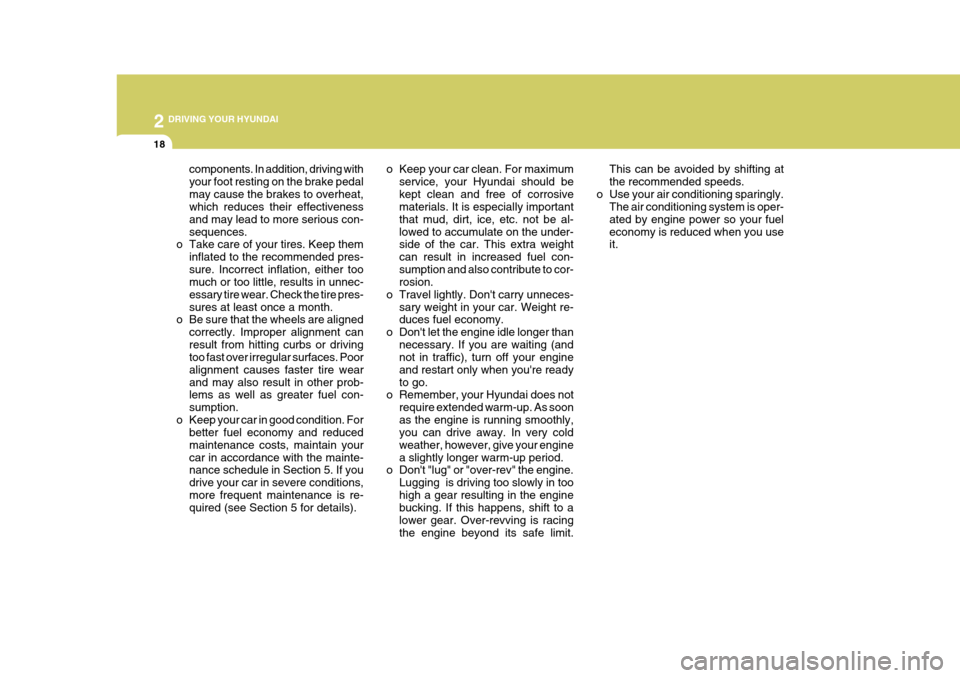
2 DRIVING YOUR HYUNDAI
18
components. In addition, driving with your foot resting on the brake pedalmay cause the brakes to overheat, which reduces their effectiveness and may lead to more serious con-sequences.
o Take care of your tires. Keep them
inflated to the recommended pres-sure. Incorrect inflation, either too much or too little, results in unnec- essary tire wear. Check the tire pres-sures at least once a month.
o Be sure that the wheels are aligned
correctly. Improper alignment canresult from hitting curbs or driving too fast over irregular surfaces. Poor alignment causes faster tire wearand may also result in other prob- lems as well as greater fuel con- sumption.
o Keep your car in good condition. For better fuel economy and reducedmaintenance costs, maintain yourcar in accordance with the mainte- nance schedule in Section 5. If you drive your car in severe conditions,more frequent maintenance is re- quired (see Section 5 for details). o Keep your car clean. For maximum
service, your Hyundai should be kept clean and free of corrosive materials. It is especially important that mud, dirt, ice, etc. not be al-lowed to accumulate on the under- side of the car. This extra weight can result in increased fuel con-sumption and also contribute to cor- rosion.
o Travel lightly. Don't carry unneces- sary weight in your car. Weight re-duces fuel economy.
o Don't let the engine idle longer than necessary. If you are waiting (andnot in traffic), turn off your engine and restart only when you're readyto go.
o Remember, your Hyundai does not
require extended warm-up. As soonas the engine is running smoothly, you can drive away. In very cold weather, however, give your enginea slightly longer warm-up period.
o Don't "lug" or "over-rev" the engine.
Lugging is driving too slowly in toohigh a gear resulting in the engine bucking. If this happens, shift to a lower gear. Over-revving is racingthe engine beyond its safe limit. This can be avoided by shifting atthe recommended speeds.
o Use your air conditioning sparingly. The air conditioning system is oper-ated by engine power so your fueleconomy is reduced when you use it.
Page 173 of 277
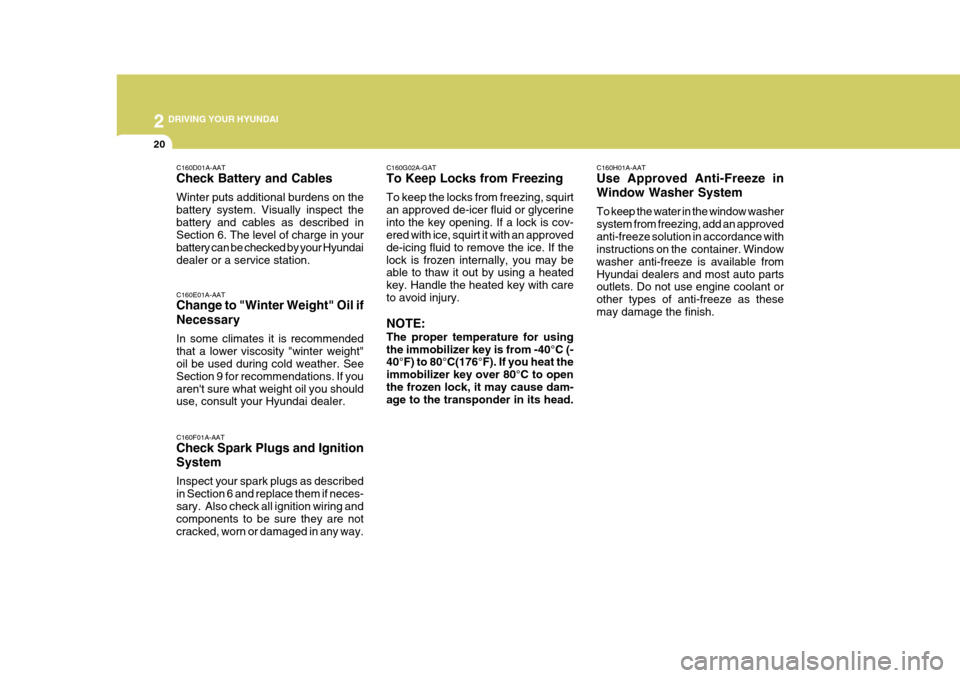
2 DRIVING YOUR HYUNDAI
20
C160H01A-AAT Use Approved Anti-Freeze in Window Washer System To keep the water in the window washer system from freezing, add an approvedanti-freeze solution in accordance with instructions on the container. Window washer anti-freeze is available fromHyundai dealers and most auto parts outlets. Do not use engine coolant or other types of anti-freeze as thesemay damage the finish.
C160G02A-GAT To Keep Locks from Freezing To keep the locks from freezing, squirt an approved de-icer fluid or glycerineinto the key opening. If a lock is cov- ered with ice, squirt it with an approved de-icing fluid to remove the ice. If thelock is frozen internally, you may be able to thaw it out by using a heated key. Handle the heated key with careto avoid injury. NOTE: The proper temperature for using the immobilizer key is from -40°C (- 40°F) to 80°C(176°F). If you heat the immobilizer key over 80°C to openthe frozen lock, it may cause dam- age to the transponder in its head.
C160D01A-AAT Check Battery and Cables Winter puts additional burdens on the battery system. Visually inspect thebattery and cables as described in Section 6. The level of charge in your battery can be checked by your Hyundaidealer or a service station. C160F01A-AAT Check Spark Plugs and Ignition System Inspect your spark plugs as described in Section 6 and replace them if neces-sary. Also check all ignition wiring and components to be sure they are not cracked, worn or damaged in any way.
C160E01A-AAT Change to "Winter Weight" Oil if Necessary In some climates it is recommended that a lower viscosity "winter weight" oil be used during cold weather. See Section 9 for recommendations. If youaren't sure what weight oil you should use, consult your Hyundai dealer.
Page 176 of 277

2
DRIVING YOUR HYUNDAI
23
NOTE: If you tow a trailer or vehicle, your car will require more frequent main- tenance due to the additional load.See "Maintenance Under Severe Usage Conditions" on page 5-7.
CAUTION:
o Never connect a trailer brake sys- tem directly to the vehicle brakesystem.
o When towing a trailer on steep grades (in excess of 12%) pay close attention to the engine cool-ant temperature gauge to ensure the engine does not overheat. If the needle of the coolant tem-perature gauge moves across the dial towards "H" (HOT), pull over and stop as soon as it is safe todo so, and allow the engine to idle until it cools down. You may proceed once the engine hascooled sufficiently.
! C190D01A-GAT Safety Chains Should the hitch connection between your car and the trailer or vehicle youare towing fail, the trailer or vehicle could wander dangerously across other lanes of traffic and ultimately collidewith another vehicle. To eliminate this potentially dangerous situation, safety chains, attached between your car andthe trailer or towed vehicle, are re- quired in most provinces.
C190E02E-GAT Trailer Weight Limit
Tongue load Total trailer weight C190E01L
Tongue loads can be increased or decreased by redistributing the load in the trailer. This can be verified bychecking the total weight of the loaded trailer and then checking the load on the tongue. NOTE:
1. Never load the trailer with more weight in the back than in the front. About 60% of the trailerload should be in the front half on the trailer and the remaining 40% in the rear.
Page 177 of 277

2 DRIVING YOUR HYUNDAI
24
!
kg
CAUTION:
The following specifications are recommended when towing atrailer. The loaded trailer weight cannot safely exceed the values in the following chart.
!
5. The maximum permissible over- hang of the coupling point : 1,095 mm
C190E02L
Gross Axle Weight
Coupling pointC190E03E WARNING:
Improperly loading your car andtrailer can seriously affect its steer- ing and braking performance caus-ing a crash which could cause seri- ous injury or death.
Tongue
4 Door : 65 5 Door : 60
With BrakeType Without Brake Type Maximum Towable
Weight
1.6 L
1.8/2.0 L Trailer
1,200 1,400 550
Gross Vehicle
Weight
2. The total gross vehicle weight with trailer must not exceed the Gross Vehicle Weight Rating (GVWR) shown on the vehicle identification plate (see page 8-2). The total gross vehicle weight is the combined weight of the vehicle, driver, all passengersand their luggage, cargo, hitch, trailer tongue load and other op- tional equipment.
3. The front or rear axle weight must not exceed the Gross Axle WeightRating (GAWR) shown on thevehicle identification plate (see page 8-2). It is possible that your towing package does not exceedthe GVWR but exceeds the
65 kg 60 kg
4 Door5 Door
GAWR. Improper trailer loading and/or too much luggage in thetrunk can overload the rear axle. Redistribute the load and check the axle weight again.
4. The maximum permissible static vertical load on the coupling de-vice ;
Page 245 of 277
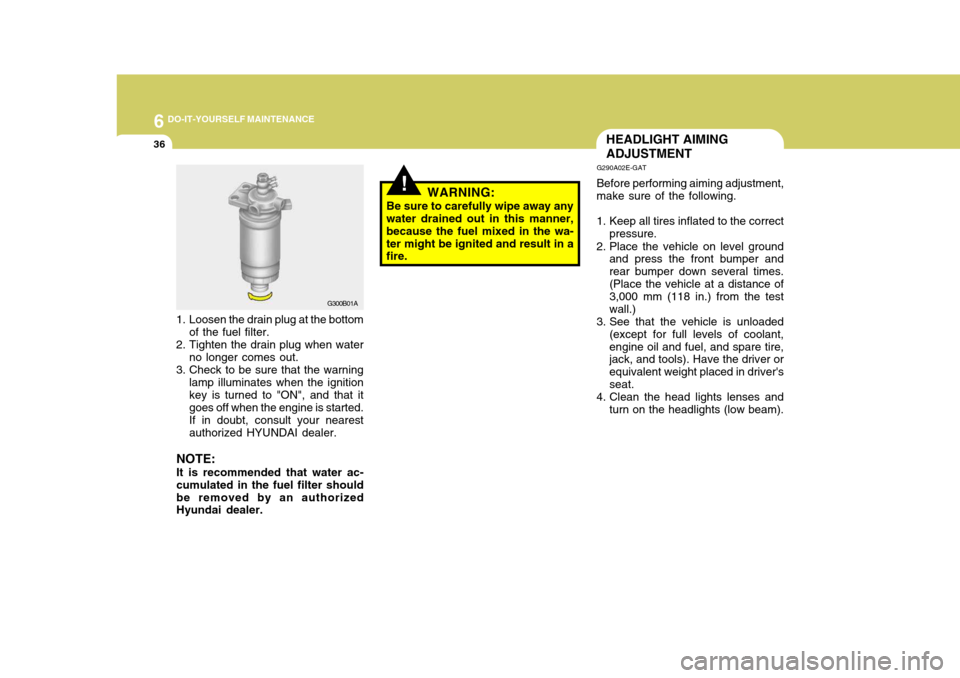
6 DO-IT-YOURSELF MAINTENANCE
36HEADLIGHT AIMING ADJUSTMENT
G290A02E-GAT Before performing aiming adjustment,
make sure of the following.
1. Keep all tires inflated to the correct
pressure.
2. Place the vehicle on level ground and press the front bumper and rear bumper down several times.(Place the vehicle at a distance of 3,000 mm (118 in.) from the test wall.)
3. See that the vehicle is unloaded
(except for full levels of coolant,engine oil and fuel, and spare tire, jack, and tools). Have the driver or equivalent weight placed in driver'sseat.
4. Clean the head lights lenses and
turn on the headlights (low beam).
!WARNING:
Be sure to carefully wipe away any water drained out in this manner, because the fuel mixed in the wa-ter might be ignited and result in a fire.
G300B01A
1. Loosen the drain plug at the bottom of the fuel filter.
2. Tighten the drain plug when water no longer comes out.
3. Check to be sure that the warning lamp illuminates when the ignition key is turned to "ON", and that it goes off when the engine is started. If in doubt, consult your nearest authorized HYUNDAI dealer.
NOTE: It is recommended that water ac- cumulated in the fuel filter shouldbe removed by an authorized Hyundai dealer.